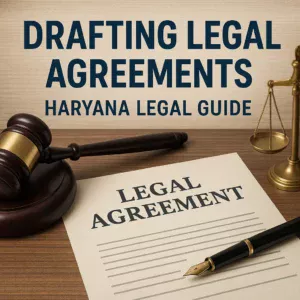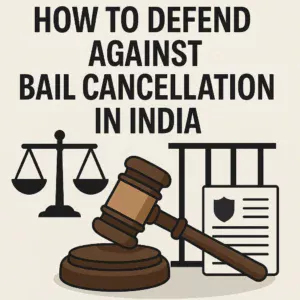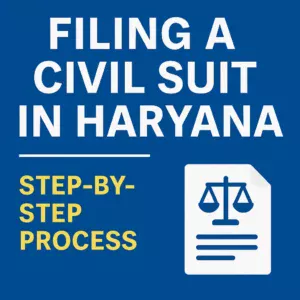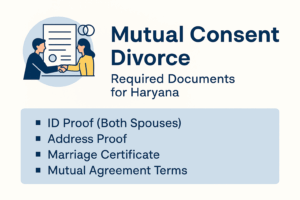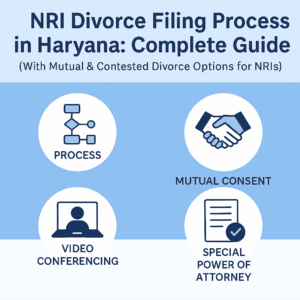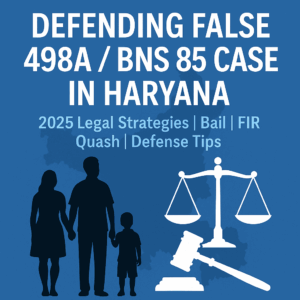In this article we have explained Online Divorce Through Video Conferencing
Introduction
In the digital age, technology has revolutionized the way we conduct our lives, including the legal processes. One such innovation is the possibility of obtaining a divorce through video conferencing, which has become increasingly relevant under Indian law. This method offers a streamlined, efficient alternative to traditional court appearances, especially in times when physical presence is challenging. This article delves into the nuances of online divorce through video conferencing in India, providing a clear, step-by-step guide to navigating this modern legal process.
Understanding Online Divorce in India
Objective: To clarify the concept of online divorce in India, including its legal framework, applicability, and process.
Legal Framework:
Online divorce in India is a relatively new concept that falls under the ambit of the Indian legal system’s acceptance of digital processes. The legal validity of online divorce comes from the Indian judiciary’s adaptation to technology, especially highlighted during the COVID-19 pandemic when courts started hearing cases virtually.
Applicability:
Online divorce primarily applies to uncontested divorces, where both parties agree on the terms of the divorce, including alimony, child custody, and division of property. This method simplifies the process, making it faster and less cumbersome for both parties and the legal system.
Process:
- Filing for Divorce: One of the spouses files a divorce petition online through the official e-filing portal of the Indian judiciary or through the website of the specific High Court or District Court, where available.
- Documents Submission: The necessary documents, such as marriage certificates, identity proofs, and agreements on alimony, child custody, etc., are submitted online. These documents must be scanned and uploaded in the prescribed format.
- Video Conferencing for Hearings: Once the application is processed, the court schedules hearings via video conferencing. Both parties and their lawyers participate in these hearings from their respective locations.
- Mutual Consent and Settlement: In cases of mutual consent divorce, both parties present their agreement on various issues before the court through video conferencing. The court may ask questions to ascertain the voluntariness of the consent and the fairness of the agreement.
- Decree of Divorce: If the court is satisfied, it passes the decree of divorce, officially dissolving the marriage. This decree is sent electronically to both parties.
Challenges and Limitations:
- Technology Access: Limited access to technology in rural areas can be a hurdle.
- Legal Awareness: Awareness about the option of online divorce is still growing.
- Complex Cases: Contested divorces, involving disputes over custody, alimony, or property, might not be fully resolvable online and may require physical hearings.
Online Divorce Through Video Conferencing: A Comprehensive Guide Under Indian Law
Filing for Divorce Online
Objective: To detail the procedure for filing for divorce online within the Indian legal context, highlighting the steps involved, necessary documentation, and legal prerequisites.
Prerequisites:
- Mutual Consent: For online filing, the divorce must generally be uncontested, meaning both spouses agree to the divorce and its terms.
- Documentation: Parties must have digital copies of all necessary documents, such as marriage certificates, identity proofs, financial statements, and any agreement on alimony, child custody, and property division.
Steps to File for Divorce Online:
- E-Filing Portal Registration: The first step involves registering on the e-filing portal of the Indian Judiciary or the specific High Court or District Court’s website that offers the service. This process requires providing basic information and setting up a user account.
- Filling Out the Application Form: The divorce application form must be filled out online. This form asks for details about both spouses, the marriage, reasons for divorce, and terms of settlement if applicable.
- Uploading Documents: Upload all required documents in the prescribed format. This typically includes the marriage certificate, photographs, identity proofs of both parties, and any agreements regarding alimony, custody, or property.
- Payment of Fees: A fee is usually required to process the divorce application. This fee varies depending on the court and the type of divorce application. The payment can typically be made online through the portal.
- Submission and Acknowledgment: After reviewing the application and attachments for completeness and accuracy, submit the application through the online portal. Upon submission, you will receive an acknowledgment or a case number, which can be used to track the progress of your case.
- Notice to the Other Party: Depending on the jurisdiction and specific court rules, the court may serve a notice to the other spouse electronically or require the applicant to do so through a process server.
- Hearing Schedule: The court then schedules a hearing, which may be conducted via video conferencing. Both parties and their legal representatives need to be present online at the scheduled time.
Key Considerations:
- Accuracy of Information: Ensure that all information provided in the application and documents is accurate and truthful to avoid legal repercussions.
- Legal Representation: Even in an online process, having a lawyer can help navigate the legal intricacies and ensure that the settlement agreement is fair and in accordance with the law.
- Confidentiality: Be aware of the confidentiality of the information submitted online and ensure that the e-filing portal is secure and officially recognized by the Indian judiciary.
Challenges:
- Limited to uncontested divorces in many cases.
- Technical issues or lack of internet access can pose challenges.
- Awareness and understanding of the online process can vary.
Video Conferencing Proceedings
Objective: To elucidate the process and significance of video conferencing proceedings in the context of online divorce under Indian law, highlighting the procedural aspects, benefits, and challenges.
Framework and Significance:
- Legal Basis: Indian courts have increasingly adopted video conferencing as a legitimate means to conduct hearings, including divorce proceedings. This shift is supported by amendments in procedural laws and guidelines issued by the Supreme Court of India, aimed at ensuring justice is accessible even in circumstances where physical presence is challenging.
- Purpose: Video conferencing in divorce proceedings serves to expedite the process, making it more convenient for parties to present their cases without the need for physical presence in court, thus reducing the emotional and financial strain.
Procedure:
- Scheduling: Once a divorce petition is filed online and all requisite documents are submitted, the court schedules a hearing date. The parties are informed of this date, and instructions are provided on how to join the video conference, usually through an email containing a link to the virtual courtroom.
- Technical Setup: Participants need a stable internet connection, a webcam, and a microphone. Most courts use secure and officially sanctioned platforms for these proceedings to ensure confidentiality and security.
- Joining the Session: On the scheduled date and time, parties and their legal representatives join the video conference. Courts typically have a technical support team to assist with any connectivity or technical issues.
- Conducting the Hearing:
- Identification: The judge or court official first verifies the identity of the participants.
- Presentation: Both parties are given the opportunity to present their case, submit evidence, and make arguments, just as they would in a physical courtroom setting.
- Questioning: The judge may ask questions to clarify points or to gather additional information. Witnesses can also be called and examined during these sessions.
- Recording: Proceedings are often recorded for record-keeping and to ensure transparency.
- Decision: After hearing both sides, the court may pass a judgment immediately or schedule another date for the announcement. In cases of mutual consent, the divorce can sometimes be finalized in a single hearing.
Benefits:
- Accessibility: Enables parties to participate in proceedings from anywhere, reducing travel costs and time.
- Efficiency: Speeds up the legal process, allowing courts to handle more cases.
- Safety: Particularly important during health crises like the COVID-19 pandemic, offering a safe alternative to physical court appearances.
Challenges:
- Technical Issues: Connectivity problems or technical glitches can cause delays.
- Confidentiality Concerns: Ensuring the privacy and security of the proceedings is paramount, requiring secure video conferencing tools.
- Digital Divide: Limited access to or familiarity with technology among certain populations can pose barriers.
Finalizing the Divorce
If the court is satisfied with the mutual agreement and the grounds for divorce, it can pronounce the divorce decree through video conferencing. This decree is legally binding and marks the official dissolution of the marriage.
Advantages of Online Divorce Through Video Conferencing
- Convenience and Accessibility: Parties can participate from any location, reducing the need for travel and physical presence in court.
- Time and Cost Efficiency: It speeds up the process and reduces the expenses associated with court appearances.
- Safety: Particularly relevant during health crises like the COVID-19 pandemic, it offers a safer alternative to in-person hearings.
Challenges and Considerations
While online divorce through video conferencing offers numerous benefits, there are challenges such as technology access, privacy concerns, and the need for both parties to agree on the divorce terms. It’s crucial to have reliable legal advice and technological support throughout the process.
Conclusion
Online divorce through video conferencing in India represents a significant shift towards modernizing the legal process. It aligns with the need for more accessible, efficient, and safe legal proceedings. By understanding the legal framework, process, and requirements, individuals can navigate their divorce proceedings with greater ease and convenience. As technology continues to evolve, it is likely that more legal processes will adopt online methods, further transforming the landscape of the Indian legal system.
FAQ on Online Divorce Through Video Conferencing in India
1. What is an online divorce through video conferencing?
Online divorce through video conferencing is a legal process that allows couples to obtain a divorce without physically attending court. It involves using video conferencing technology for hearings and proceedings.
2. Is online divorce through video conferencing legal in India?
Yes, it is legal in India. The Supreme Court has approved the use of video conferencing for legal proceedings, including divorce.
3. Who is eligible for an online divorce in India?
Couples seeking a mutual consent divorce, where both parties agree on terms such as alimony, child custody, and property division, are eligible for online divorce.
4. What documents are required for filing an online divorce?
Required documents typically include the marriage certificate, identity proofs, and a mutual agreement on divorce terms.
5. How do I start the online divorce process?
The process starts by filing a divorce petition online with the relevant family court, followed by proceedings through video conferencing.
6. Can we settle property and custody issues through online divorce?
Yes, property and custody issues can be settled if both parties reach a mutual agreement, which is then approved by the court.
7. Is a lawyer required for online divorce proceedings?
While not mandatory, it’s highly recommended to have legal representation to navigate the legal proceedings effectively.
8. How long does the online divorce process take in India?
The duration varies but mutual consent divorces through video conferencing can be quicker than traditional methods, potentially taking 6 to 18 months.
9. What are the technical requirements for online divorce proceedings?
Participants need a reliable internet connection, a device with a camera and microphone, and access to the court-approved video conferencing software or app.
10. Are online divorce proceedings recorded?
Yes, proceedings are often recorded for legal documentation and reference, adhering to the court’s protocols.
11. Can an NRI use the online divorce process in India?
Yes, NRIs can utilize online divorce proceedings if their marriage is registered in India or if they or their spouse is an Indian citizen.
12. What is the cost of an online divorce in India?
Costs vary based on lawyer fees and court charges, but online divorces may reduce travel and logistical expenses.
13. Can I oppose a divorce petition in an online hearing?
Yes, you can oppose a divorce petition during an online hearing, similar to in-person court proceedings.
14. Is my presence required during the online divorce hearing?
Yes, both parties must be present during the online hearing, though physically separate locations are permissible.
15. Can I file for divorce online without mutual consent?
Online filing is possible, but non-mutual consent cases might not be fully resolved through video conferencing alone and may require in-person hearings.
16. How is child custody determined in an online divorce process?
Child custody is determined based on mutual agreement between the parties or court judgment, taking the child’s best interest into consideration.
17. Can the online divorce decree be challenged or appealed?
Yes, like any legal decision, the online divorce decree can be challenged or appealed in a higher court.
18. What happens if we cannot reach a mutual agreement?
If mutual agreement cannot be reached, the case may proceed to a contested divorce, requiring further legal proceedings.
19. Is online divorce faster than traditional divorce?
Online divorce, especially in mutual consent cases, can be faster due to reduced logistical delays.
20. How is alimony determined in an online divorce?
Alimony is determined based on mutual agreement or court discretion, considering factors like duration of marriage, spouse’s income, and living standards.
21. Can we reconcile after filing for an online divorce?
Yes, couples can reconcile and withdraw their divorce petition before the final decree is pronounced.
22. What if my spouse does not consent to an online divorce?
If your spouse does not consent, you may not be able to proceed with an online mutual consent divorce and might have to file for a contested divorce.
23. Are online divorces confidential?
Yes, online divorces are treated with the same level of confidentiality as traditional proceedings.
24. How do I know if my divorce has been finalized?
The court will issue a divorce decree, marking the official dissolution of marriage, which can be provided digitally or in hard copy.
25. Can a single lawyer represent both of us in an online divorce?
It’s not recommended as it may lead to a conflict of interest. Each party should ideally have their own lawyer.
26. What if there are technical issues during the video conference?
Courts usually have protocols for technical issues, including rescheduling the hearing if necessary.
27. Can all family courts in India handle online divorces?
The capability varies by region, but most family courts in India are equipped to handle online proceedings.
28. How do I find a lawyer for an online divorce?
You can find a lawyer through legal directories, referrals, or online platforms specializing in family law.
29. What is the success rate of online divorces?
Success rates are comparable to traditional divorces, especially in mutual consent cases where agreements are pre-decided.
30. Can I remarry immediately after my online divorce is finalized?
Under Indian law, there is a waiting period before remarrying, which can vary; legal consultation is advised to understand specific timelines.



